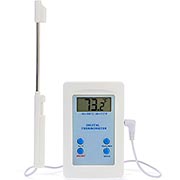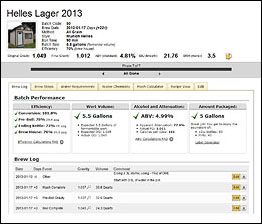 Today’s guest post is from Larry of Brewer’s Friend. He shares some insights on how to improve your home brewing calculations.
Today’s guest post is from Larry of Brewer’s Friend. He shares some insights on how to improve your home brewing calculations.
————————————————
The science of brewing can be just as alluring as the smells, tastes, and never ending equipment accumulation related to home brewing. Brewing science is a wide topic that includes everything from yeast growth, to hops analysis, to the various brewing processes.
Let’s start at the beginning: the science and stats behind beer recipes. Beer recipes have several stats including original gravity, final gravity, IBUs (bitterness), SRM (color), and ABV (alcohol content).
A quick walk through of the stats:
- Original Gravity (OG) – Original gravity tells how much sugar is in the wort prior to fermentation. This is based on how much grain was used, what the volume of the batch is, and mash efficiency (for all grain brewers). This is where the term ‘high gravity beer’ comes from. The higher the OG the higher the alcohol potential. There are two popular gravity scales used in brewing, specific gravity and degrees Plato. Specific gravity (1.xxx) is popular in the home brewing world. Plato is generally used by pro brewers and works well with the metric system.
- Final Gravity (FG) – Final gravity tells how much sugar the wort contains after fermentation. FG depends on the fermentability of the wort and the yeast strain selected. Other factors like temperature, yeast health, alcohol level, and mash temperature also impact the FG. The FG is the gravity of the completely fermented beer.
- Alcohol by Volume (ABV) – ABV is calculated using the difference between the OG and FG. The higher the OG and the lower the FG, the more alcohol is in the beer.
- International Bittering Units (IBUs) – IBUs indicate how bitter a beer is. Perceived bitterness can be different from the raw IBU number. A malty beer at 60 IBUs compared to a thin dry beer at 40 IBUs may appear to have equal bitterness.
- Standard Reference Measure (SRM) – SRM is the color the beer is expected to be given the grains used. Base grains like 2-row and pilsner impart straw/golden colors. Caramel grains add red, copper, and brown hues. Roasted grains impart dark brown and black color.
Beer recipe software can be used to calculate all of these numbers:
Brewer’s Friend has set of over 20 basic calculators, plus a fully integrated recipe editor.
Taking measurements:
For taking gravity readings (the OG and FG) a hydrometer or refractometer is used. I find both work well as an essential tool for record keeping, but prefer hydrometers for their economy and consistent accuracy. Refractometers can be a little finicky at times in terms of accuracy, but they only require a drop or two of wort vs. a few ounces with hydrometer readings.
Don’t forget to pickup a graduated cylinder to hold the hydrometer sample!
Note: Hydrometer readings must be temperature corrected, since gravity density changes with temperature. Hydrometers are usually calibrated to 60F or 68F. Brewer’s Friend has a hydrometer temperature correction calculator that comes in handy. This way, even if your sample is still at a warm 100F, you can get a good idea of what the actual value is before it cools down.
Refractometer readings are given in Brix (which is effectively the same as Plato), but many home brewers work in specific gravity. Our refractometer calculator automatically handles this conversion, and accounts for the optional correction factor that some refractometers require.
Unfortunately there is no simple gadget to measure IBUs. The process is quite complex and requires a beer sample to be sent to a lab for analysis. Someday, maybe we’ll see a Kickstarter project that delivers IBU measurements in a hand held device?!
 Recording your measurements:
Recording your measurements:
Brewer’s Friend supports a brew feature that allows log entries for tasting notes, dates, and most importantly gravity and volume measurements. The log entries are used to calculate the batch’s actual ABV, efficiency, attenuation, and other stats so brewers know how their beer really turned out in comparison to a planned recipe.
Other important beer recipe calculations:
- One way to take your brewing to the next level is to pitch yeast at the pro rates. This usually involves making a starter from a smack pack or vial. Brewer’s Friend has an easy to use yeast pitch calculator, which makes sure you pitch the right amount of yeast for your beer.
- Water chemistry is also important in brewing. I pay close attention to my ion levels in every brew. Brewer’s Friend has two water chemistry calculators. The first is a basic version targeted at hitting water ion levels for style and taste. The second water chemistry calculator is an advanced version meant for use by all grain brewers, and gives a prediction of mash pH among many other little details. The backend to our advanced calculator was written by Kaiser of Braukaiser.com.
The team behind Brewer’s Friend is a group of highly dedicated and experienced brewers, bloggers, and technologists whose mission is to make your brewing the best it can be. Check out our website for all your brewing calculation needs and don’t hesitate to reach out with any questions!
Cheers!
Guest post by Larry at Brewer’s Friend
https://www.brewersfriend.com
